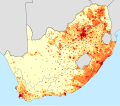Seswantšho:South Africa 2011 population density map (hex cells).svg

Size of this PNG preview of this SVG file: 681 × 600 pixels. Other resolutions: 272 × 240 pixels | 545 × 480 pixels | 872 × 768 pixels | 1,162 × 1,024 pixels | 2,325 × 2,048 pixels | 807 × 711 pixels.
''resolution'' ya gofella (SVG faele, nominally 807 × 711 pixels, bogolo ba faele: 1.41 MB)
Histori ya faele
Pinyeletša go letšatšikgwedi/nako go bona faela ka tsela yeo ebego e le ka gona nakong yeo.
| LetšatšiKgwedi/Nako | Nkgogorupo-Nala | Bogolo | Mošomiši | Comment | |
|---|---|---|---|---|---|
| bjale | 17:43, 10 Hlakola 2021 |  | 807 × 711 (1.41 MB) | Htonl | == {{int:filedesc}} == {{Information |Description={{en|1=Population density map of South Africa, based on the 2011 census, using data aggregated to regular 50km<sup>2</sup> hexagonal cells. {{legend|#ffffcc|<1 inhabitant/km²}} {{legend|#ffeda0|1–3 inhabitants/km²}} {{legend|#fed976|3–10 inhabitants/km²}} {{legend|#feb24c|10–30 inhabitants/km²}} {{legend|#fd8d3c|30–100 inhabitants/km²}} {{legend|#fc4e2a|100–300 inhabitants/km²}} {{legend|#e31a1c|300–1000 inhabitants/km²}} {{legend|#bc0026|1... |
Tirišo ya Faele
Letlakala le ke latelago a hlomaganya go faele ye:
Global file usage
The following other wikis use this file:
- Usage on en.wikipedia.org
- Usage on eu.wikipedia.org
- Usage on he.wikivoyage.org
- Usage on tum.wikipedia.org


